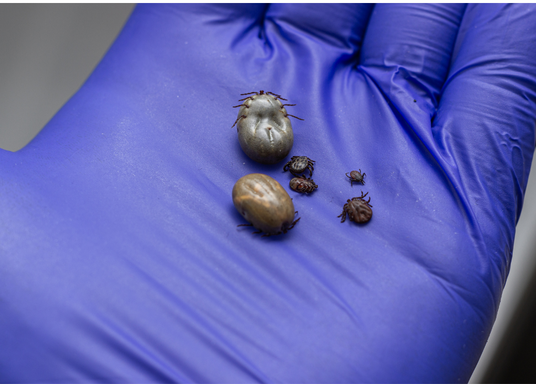While ticks pose a threat to our pets all year round, peak tick season in the UK begins from March and extends right through to October.
What are ticks?
Ticks are small, blood-sucking parasites who are part of the spider family. Humans and animals alike can serve as their hosts. Once they latch on, they can drink the blood of their host for as many as 7 days before dropping off. As you can see below, the body of a tick becomes engorged after feeding and can swell to the size of a coffee bean.

What ticks do we have in the UK?
The most common tick in the UK is Ixodes ricinus, more commonly known as the sheep tick. Less common ticks in the UK include the hedgehog tick and fox or badger tick.
What diseases do ticks carry?
While tick bites are typically painless, they pose a threat through the diseases they carry and can transmit to their host while feeding. Tick-borne diseases include Lyme disease – a serious bacterial infection which can affect both humans and dogs (Lyme disease is uncommon in cats).
Symptoms of infection to watch out for include:
- Depression
- Loss of appetite
- Fever
- Lameness
- Swollen and painful joints
- Swollen lymph nodes
- Lethargy
Babesiosis is another disease caused by ticks which affects your pet’s red blood cells and can cause severe anaemia, sometimes with fatal consequences.
Where do pets pick up ticks?
Ticks can be found in grasses and plants. They catch their next host through a behaviour known as questing. They position themselves at the ends of long pieces of vegetation, stretching out with their front legs. When an animal brushes past, they cling on, working their way through the hair until they reach the skin where they bite and attach themselves firmly.
Check your pet over for ticks when you know they’ve been exploring woodland, heathland and any areas with long grass.
Where to find a tick on your pet
Here are some common areas to check your pet for ticks:
- Under your pet’s collar
- Around the groin area
- Under your pet’s front legs
- Under their tail
- Between their toes
- Inside their ears
How to remove a tick
Removing a tick as soon as you find one can help to reduce the chances of your pet picking up a tick-borne disease. The longer a tick is latched onto your pet, the higher the risk of them becoming infected.
It’s important to remove a tick correctly. Never attempt to remove a tick by squeezing, crushing or pulling it. To remove a tick, use a tick hook. These are very cheap and readily available. It’s important you don’t use tweezers – doing so risks separating the head from the rest of the body, leaving the head embedded in your pet’s skin which could become infected.
Simply slide the tick hook underneath the tick, twist & pull and the entire tick should be removed. Wear gloves while doing this to keep yourself safe and dispose of the tick by crushing it in tissue paper, then flushing it down the toilet.
Tick protection for pets
Speak to your vet who will be able to advise on the best way of protecting your pet against ticks. This could be in the form of a collar, spot-on treatment or tablets. It’s also important to consider the risk of ticks to your pets while travelling abroad, particularly if you’re visiting a high risk area.




